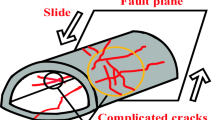Abstract
Damage analyses of rectangular cut-and-cover tunnels are performed to define the damage states and corresponding damage indices (DIs) under seismic loading. Single, double, and triple box structures designed for metro subway systems in South Korea are used. The tunnel structures are modeled by nonlinear frame elements attached to a series of normal and shear springs to simulate the soil–tunnel interaction. Pushover analyses are performed to develop the capacity curves and to monitor the development of plastic hinges. Parallel elastic analyses are also performed to determine the elastic moments at which plastic hinges form. For each tunnel and site condition, three damage states, which are minor, moderate, and extensive, are defined in terms of number of plastic hinges that form at the corners of the tunnel structure. Each damage state is linked to the corresponding DI, which is defined as the ratio of the elastic moment to the yield moment and free-field shear strain. DI for the single box tunnel is shown to be mostly independent of the shear wave velocity of soil. The values of DIs for single, double, and triple box tunnels range from 1.0 to 2.0. It is highlighted that the proposed damage state associated with DI and shear strain provide an enhanced estimate of the seismically induced damage of box tunnels and can be easily utilized in a performance-based design.

















Similar content being viewed by others
References
An X, Maekawa K (1997) Failure analysis of underground RC frame subjected to seismic actions. J Mater Concr Struct Pavements Jpn Soc Civ Eng (JSCE) 36:251–267
Andreotti G, Lai CG, Martinelli M (2013) Seismic fragility functions of deep tunnels: a new cumulative damage model based on lumped plasticity and rotation capacity. Paper presented at the ICEGE Istanbul, Turkey
Argyroudis S, Pitilakis K (2012) Seismic fragility curves of shallow tunnels in alluvial deposits. Soil Dyn Earthq Eng 35:1–12
Bobet A (2003) Effect of pore water pressure on tunnel support during static and seismic loading. Tunn Undergr Space Technol 18:377–393
Chang J, Park D, Kim D-K (2014) Seismic analysis of shallow cut and cover tunnel via frame analysis. J Korean Geotech Soc (submitted)
Dowding CH, Rozan A (1978) Damage to rock tunnels from earthquake shaking. J Geotech Eng Div 104:175–191
Hashash YM, Hook JJ, Schmidt B, John I, Yao C (2001) Seismic design and analysis of underground structures. Tunn Undergr Space Technol 16:247–293
Hashash YMA, Park D, Yao JIC (2005) Ovaling deformations of circular tunnels under seismic loading, an update on seismic design and analysis of underground structures. Tunn Undergr Space Technol 20:435–441
Hashash Y, Karina K, Koutsoftas D, O’Riordan N (2010) Seismic design considerations for underground box structures. Paper presented at the Earth Retention Conference, Washington
Huo H, Bobet A, Fernández G, Ramírez J (2006) Analytical solution for deep rectangular structures subjected to far-field shear stresses. Tunn Undergr Space Technol 21:613–625
Iai S (2005) International standard (ISO) on seismic actions for designing geotechnical works—an overview. Soil Dyn Earthq Eng 25:605–615
Khani S, Homami P (2014) Seismic performance of shallow underground subway stations in soft soil. J Eng Geol 8:1983–2002
Liu J, Liu X (2008) Pushover analysis of Daikai subway station during the Osaka-Kobe earthquake in 1995. Paper presented at the 14th world conference on earthquake engineering, Beijing, China
MLTM (2009) Earthquake resistance design regulations for subway structures. Ministry of Land, Transport and Maritime Affais
Moehle J, Elwood K, Sezen H (2002) Gravity load collapse of building frame during earthquakes ACI Special Publication 197
Nakamura S, Yoshida N, Iwatate T (1996) Damage to Daikai subway station during the 1995 Hyogoken-Namvu earthquake and its investigation. JSCE, Committee of Earthquake Engineering
Owen GN, Scholl RE (1981) Earthquake engineering of large underground structures: final report. The Division; National Technical Information Service
Park D, Sagong M, Kwak DY, Jeong CG (2009) Simulation of tunnel response under spatially varying ground motion. Soil Dyn Earthq Eng 29:1417–1424
Parra-Montesinos GJ, Bobet A, Ramirez JA (2006) Evaluation of soil–structure interaction and structural collapse in Daikai subway station during Kobe earthquake. ACI Struct J 1:113–122
Penzien J (2000) Seismically induced racking of tunnel linings. Int J Earthq Eng Struct Dyn 29:683–691
Sharma S, Judd WR (1991) Underground opening damage from earthquakes. Eng Geol 30:263–276
Wang JM (1985) The distribution of earthquake damage to underground facilities during the 1976 Tangshan earthquake. Earthq Spectra 1:741–757
Wang JN (1993) Seismic design of tunnels: a state-of-the-art design approach. Monograph 7, Parsons Brinckerhoff Quade & Douglas, Inc., New York
Wang Z, Zhang Z (2013) Seismic damage classification and risk assessment of mountain tunnels with a validation for the 2008 Wenchuan earthquake. Soil Dyn Earthq Eng 45:45–55
Wang W, Wang T, Su J, Lin C, Seng C, Huang T (2001) Assessment of damage in mountain tunnels due to the Taiwan Chi-Chi earthquake. Tunn Undergr Space Technol 16:133–150
Yoshimura M, Takaine Y, Nakamura T (2004) Axial collapse of reinforced concrete columns. Paper presented at the 13th world conference on earthquake engineering, Vancouver, BC, Canada
Acknowledgments
This research was supported by Basic Science Research Program through the National Research Foundation of Korea (NRF) funded by the Ministry of Science, ICT and Future Planning (NRF-2015R1A2A2A01006129).
Author information
Authors and Affiliations
Corresponding author
Rights and permissions
About this article
Cite this article
Lee, TH., Park, D., Nguyen, D.D. et al. Damage analysis of cut-and-cover tunnel structures under seismic loading. Bull Earthquake Eng 14, 413–431 (2016). https://doi.org/10.1007/s10518-015-9835-x
Received:
Accepted:
Published:
Issue Date:
DOI: https://doi.org/10.1007/s10518-015-9835-x




